
The company claims that its upgraded
Wirtgen supplies the AutoPilot 2.0 for the models SP 15/SP 15i and SP 25/SP 25i, while the system can also be retrofitted to machines already in use by customers.
Typical applications for the AutoPilot 2.0 system are for making concrete safety barriers, kerbs, traffic islands or for road surfaces with a width of up to 3.5m. The 3D control package comprises a computer integrated into the machine and a tablet attached to the Field Rover survey pole. Two GPS receivers are mounted on the machine and these communicate with a GPS reference station at the job site. The satellite-based navigation system (GNSS) controls the steering and cross slope of the slipform paver fully automatically. All that is needed is the reception of a sufficient number of satellites and an operator trained to handle the system. A key benefit is with surveying time as there is no need to set up, dismantle or maintain string lines. In addition, paving crews no longer need to take care working around a string line, which can be easily damaged.
Removing the string lines also means that the concrete mixers have more space for manoeuvring, making it easier to supply the slipform paver with material. There is also no need to generate a geodetic data model in advance and overall, works can be carried out more quickly and efficiently according to the firm.
The software also features tools that can be used in a similar way as setting up a conventional string line. To achieve the best paving quality, the software automatically tests the imported or newly created data for kinks affecting steering and height control and displays these on the tablet. The user can then correct unwanted kinks in the model data by rounding them with a few simple steps on the touchscreen using graphic editors.
After quality testing, the tablet is connected to the machine control of the slipform paver and the design generated is put into the machine’s control system. The concrete paver then starts on its own at the specified starting point and progresses automatically along the predefined course.
The firm claims that the simplicity of the system means that users are able to create designs, check data and pave complex layouts in a short time, using the tablet. Existing objects on the job site can be included quickly and easily into the data. Meanwhile, users retain full control and can intervene in the autonomous paving process at any time.









